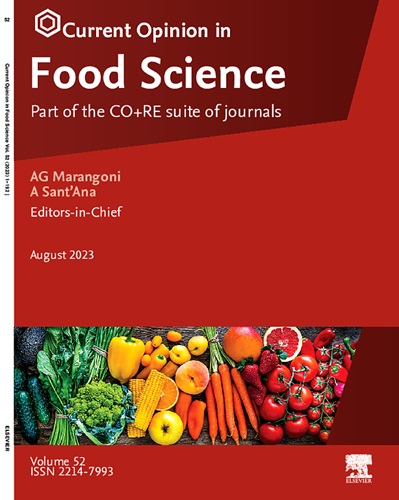Constructing aqueous foams from milk components: structure and interfaces
IF 9.1
1区 农林科学
Q1 FOOD SCIENCE & TECHNOLOGY
引用次数: 0
Abstract
Milk foams are complex colloid systems including protein dispersion foam, emulsion foam, and oleofoam. Bovine milk is a unique colloid mixture containing diversified surface-active components, ranging from mesoscopic to molecular scales, such as proteins, milk fat globules (MFGs), fat crystals, phospholipids, etc. A comprehensive understanding about their foaming behaviors in the context of milk foam would result in cleaner-label opportunities and superior stability. Regarding practical foaming processes, interfacial adsorption or foam film formation is a net effect resulted from both thermodynamic equilibrium and kinetic aspects, in which surface tension, gravity, physicochemical properties, hydrodynamics, etc. are involved. This has a significant meaning to the water–air entering phenomenon for MFGs and to the milk (emulsion) foaming capacity and stability due to MFGs may act as both foaming and antifoaming agent. This mini-review elaborates on foaming mechanisms for milk components, knowledge gaps, and opportunities are discussed based on recent research findings.
从牛奶成分构建水泡沫:结构和界面
牛奶泡沫是一种复杂的胶体系统,包括蛋白质分散泡沫、乳液泡沫和油脂泡沫。牛乳是一种独特的胶体混合物,含有从中观到分子尺度的多种表面活性成分,如蛋白质、乳脂肪球(MFGs)、脂肪晶体、磷脂等。全面了解这些物质在牛奶泡沫中的发泡行为,将带来更清洁的标签机会和更出色的稳定性。关于实际的发泡过程,界面吸附或泡沫膜的形成是热力学平衡和动力学两方面的净效应,其中涉及表面张力、重力、物理化学特性、流体力学等。这对于乳化增稠剂的水气进入现象以及牛奶(乳液)的发泡能力和稳定性都具有重要意义,因为乳化增稠剂既可作为发泡剂,也可作为消泡剂。这篇微型综述阐述了牛奶成分的发泡机制、知识差距以及基于最新研究成果的机遇。
本文章由计算机程序翻译,如有差异,请以英文原文为准。
求助全文
约1分钟内获得全文
求助全文
来源期刊

Current Opinion in Food Science
Agricultural and Biological Sciences-Food Science
CiteScore
18.40
自引率
4.00%
发文量
157
审稿时长
92 days
期刊介绍:
Current Opinion in Food Science specifically provides expert views on current advances in food science in a clear and readable format. It also evaluates the most noteworthy papers from original publications, annotated by experts.
Key Features:
Expert Views on Current Advances: Clear and readable insights from experts in the field regarding current advances in food science.
Evaluation of Noteworthy Papers: Annotated evaluations of the most interesting papers from the extensive array of original publications.
Themed Sections: The subject of food science is divided into themed sections, each reviewed once a year.
 求助内容:
求助内容: 应助结果提醒方式:
应助结果提醒方式:


